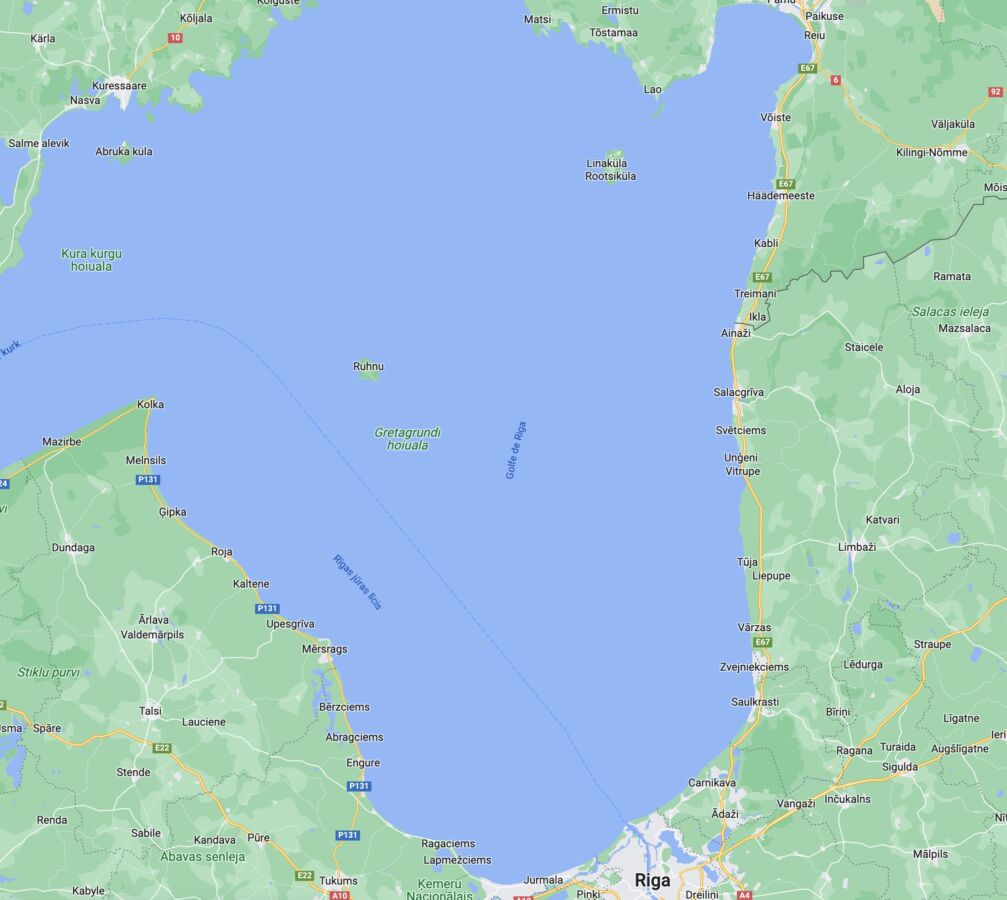Characteristics
Marine System
The surface area of the Gulf of Riga is 16 300 km², the volume is 424 km³. The salinity varies from 4 to 7 ppt (in near-coastal areas 0-2 ppt). It is connected with the open part of the Baltic Sea through the Irbe Strait and the Estonian Archipelago (Väinameri). The Gulf is an estuarine, land-dominated area. A separate ecological subsystem exists in the gulf. As there is no halocline in the gulf, the water in the bottom layers is rather cold and well aerated during the year. Therefore, a number of Ice Age relict species have found acceptable habitats there. Strong seasonal thermocline is an important factor for summer dynamics of the ecosystem. The gulf is a very productive area of the Baltic Sea. The dynamics of local populations of the gulf closely depends on periodic climate changes (mainly salinity, winter temperature and river runoff are important factors) and various anthropogenic impacts, and differ from other areas of the Baltic Sea. On the southern (Riga and its satellite towns) and eastern (Pärnu) coasts of the gulf important holiday resorts have existed long time. Nowadays the importance of tourism has enormously increased both on the mainland and especially on the islands. One of the most recent concerns is substantially increased maritime transportation (both cargo ships and leisure boats) that is an important vector for the introduction of non-indigenous species. The invasion of alien species has resulted in fundamental alterations in the structure and functioning of both the benthic and pelagic systems.
Watershed
The catchment area is rather flat and constitutes 134 000 km². Five relatively large rivers (Daugava, Lielupe, Gauja, Pärnu, Salaca) and a number of smaller rivers discharge into the gulf. The average annual freshwater inflow equals to 31 km³ (7.3 % of the volume of the gulf), 86 % of it falls into the southern part of the gulf. A number of dams have constructed on the rivers (incl. Daugava), some water reservoirs exist. The gulf is surrounded by densely populated areas as well as intensely used agricultural areas situated on the southern and eastern coasts.
Human Activities
- Industrial wastes. The main industrial pollution sources are from Riga and other towns. Intense agriculture. Intensely used agricultural areas are situated on the southern and eastern coasts.
- Other. Overfishing of valuable species. Harmful algal blooms. Invasion of alien species.
Impact Responses
- Pollution and eutrophication. The pollution with its side-effects has considerably affected the gulf ecosystem (impoverishment of species diversity, changes in the food web, increase in the frequency of harmful algae blooms, etc) and exerts additional impact to the natural stress factors of biota (limited salinity, low temperature in winter, etc).
- Overfishing. Fishing, fish processing and related professions are very important for coastal population. Mainly herring, perch, smelt, pike-perch etc are The exploitation rates are high, some valuable species are overexploited.
- Habitat destruction; deterioration of the quality of coastal waters.
Policy
Policy issues
Eutrophication, harmful algal blooms and toxic pollution of the gulf; protection of the coasts, beaches and coastal waters including the areas of intense tourism; need for the ratification of the IMO ballast water regulations; recognition of the socio-economic and ethic value of marine resources (bottom vegetation, invertebrates, fish, birds, seals) and marine environment. The key questions: 1) What is the optimum exploitation regime to grant sustainable management of local fish stocks? 2) What is the acceptable management of coastal environment to support tourism and health resorts? 3) Can we foresee the changes in the unique ecosystem under heavy invasion of alien species? 4) What is the role of maritime transportation in degradation of ecosystems?
Policy changes
During the period covered by the time series indicated below, policy changes have been in the following:
1) enforcement of fishing rules;
2) protection of marine environment and ecosystems;
3) protection of resort areas.
Stakeholders and Institutional Governance
Major organisations
- Ministry of the Environment
- Ministry of Health, County and municipal administrations
- Fishermen’s organisations, large ports – both in Estonia and Latvia
- Baltic Marine
- Environment Protection Commission
- International Council for the Exploration of the Sea.
Other leading organisations
- Tourism organisations
- Nature conservation organisations
- Holiday resorts.
Partner Collaboration
Institute of Aquatic Ecology, University of Latvia (Dr. Maija Balode).
Systems Studies
Long time series
- Hydro-meteorological data (temperature, winds, river discharge, cloudiness ) – since the 1940-50s;
- Hydrochemical data – inorganic and total N, P, Si – since 70-
- Mesozooplankton: May-July – since 1957; April-November – since
- Phytoplankton – since the
- Macrozoobenthos – since 70-
- Mysids – since
- Spring spawning herring (year-class abundance, population numbers, population biomass, mean weight at age) – since 1957:
- Smelt (year-class abundance, population numbers, population biomass, mean weight-at- age) – since 1960
- Annual fish catches – since
- Qualitative and quantitative data on feeding of herring, sprat, smelt, stickleback – since
- Trace metals and organochlorine compounds in herring – since
- Dioxins in herring – since
Research Projects
Continuous state projects:
- Investigations on dynamics and regularities of development of ecological subsystems in the North-eastern Baltic, Gulf of Finland and Gulf of Riga (2003-07).
- The impact of spatial and temporal variation of coastal processes on the biological and functional diversity (2003-07).
- State programmes on the monitoring of eutrophication (since 1994), on dangerous compounds (since 1994), of dioxin content in fish (since 2002), at the Estonian coasts.
Socio-economic study
In 2002 an investigation on the catch effort of Estonian trawl fleet was carried out (MSc thesis).




